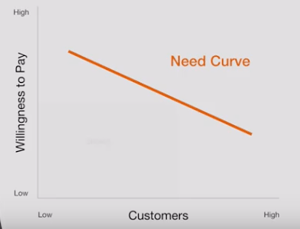Welcome to the next lesson in our online JTBD course. You will learn how to size a market using jobs-to-be-done innovation methods. In this video, we will explain how to avoid lethal market sizing mistakes and how to determine market size using customer willingness-to-pay data.
In business, the market always wins. So, if you are on a product, marketing or sales team, it is critically important that you size your market correctly. Your potential revenue and profit growth are a direct function of your market size. In this lesson, we will show you how to size a market using jobs to be done innovation methods.
Avoiding Lethal Market Mistakes
Blackberry, Britannica and Kodak all lost billions of dollars because they defined their markets incorrectly. This lead directly to their failure. This was also an enormous lost opportunity for growth because Apple, Google and Facebook created trillions of dollars in equity value in the exact same markets.
So how do you size your markets to avoid lethal market mistakes?
Traditional market definitions are flawed because they all use a product as a key variable. Jobs Theory shows that that your target customer’s are not buying your product, they are hiring your product to get a job done. So your customers job is your true market -- your target market.
In 2006, Microsoft thought there was a huge iPod market. And this made sense using the traditional market sizing equation of product price times the number of buyers. Apple had sold 200 million iPods at an average price of $150, making this a $30 billion market using the traditional equation. This is a HUGE market even for Microsoft. With all their resources and their gigantic customer base, Microsoft launched the Zune. And it was a TOTAL failure!
Their market sizing was the fatal flaw because there is no such thing as the “iPod market.” This supposed $30 billion market is now approximately ZERO! Product-based market sizing always leads to failure because all products change over time, but your customers job-to-be-done is a stable target to hit.
How to Size a Market
To size your market, first define your critical customer as the job beneficiary. In a previous lesson, we saw how critical this is.
Then, identify your customer’s functional job, as we did in the previous lesson. Together, your job beneficiary and their functional job define your market. To size your market, you want to know what your critical customer, the job beneficiary, is willing to pay to get their job done. 
With this data, you can then plot the results on what we call a Need Curve. This looks like a traditional economics demand curve of price and quantity, but we are plotting the customer’s willingness to pay and the number of customers, the job beneficiaries, in the market. The area under the Need Curve is your market size. The Need Curve enables you to identify the size of your low-cost customer segments and the size of your premium customer segments. As a result, the need curve helps you identify hidden market opportunities for greater potential sales, higher total revenue and accelerated growth.
You can use a quantitative survey as part of your market research to get willingness to pay data in consumer, business, and medical markets. Let’s look at an example in a consumer market.
Willingness to Pay Data in Consumer Markets
As we saw before, if we were competing with Apple and Google Maps for market share and we wanted to size this market using the traditional definition, the navigation app market would be an entirely unattractive market because the leading products are free. But we know the true market in this example is not navigation apps. It is the job of getting to a destination on time.
In this example, when we surveyed customers we asked them, "At what price per month would you be willing to pay to get to your destinations on time?"
In the survey, you can ask a series of market sizing questions to calculate a range of your customer’s willingness to pay. Plot your survey data on a chart to identify the the Need Curve and calculate your market size. 
In this market example, even with free competitors, including Apple and Google, there is a $2 billion premium customer segment that is willing to pay a premium price for a solution that helps them get the job done better.
Why do high-growth customer segments and market opportunities like this exist even when the leading products and services are free?
Because there are unmet customer needs in your market.
In the next lesson, you will learn how to identify your customer’s needs in their job. Identifying your customer’s needs is a critical step to satisfying unmet needs better than competitors in your market.
Contact us today to get our free how-to guides and try our jobs-to-be-done software for free.







